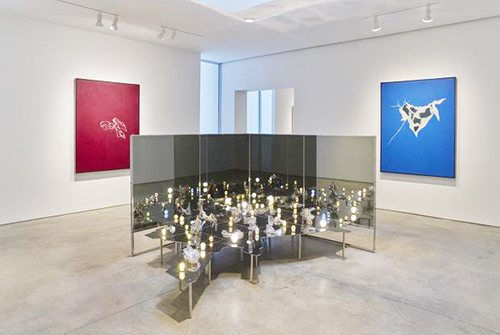이불(Lee Bul) 개인전@레만모핀 갤러리(1/12-2/11)
Lee Bul
January 12 – February 11, 2017
Lehmann Maupin (536 West 22nd St.)

Lehmann Maupin is pleased to announce an exhibition of new work by Lee Bul, who is considered to be one of the leading Korean artists of her generation. For her fifth exhibition with the gallery, Lee Bul will present a series of recent mixed media works and immersive installations. Though varied in media and content, these series are united in their exploration of structural systems—from the individual body to larger architectural frameworks that encompass cities and utopian societies—which have become a hallmark of Lee Bul’s oeuvre. The gallery will host an opening reception for the artist on Thursday, January 12, from 6-8 PM.
Lee Bul was born in the 1960s in South Korea, a period of social and economic upheaval marked by the transition from military dictatorship to a democratic state. The era had a lasting impact on Lee Bul’s practice, as it piqued an enduring interest in how individual ideologies influence greater society. Drawing inspiration from numerous literary, cinematic, and architectural sources, Lee Bul’s work is a constantly expanding inquiry into the human condition. Her multifaceted approach to exploring these ideas, through performance, sculpture, film, painting, and installation, is indicative of her unique vision and innovative aesthetic that she has been developing since the 1980s.
In her most recent series of mixed media works, Lee Bul combines organic and architectural elements. Using specialized paint that contains fragments of mother of pearl—a living organism itself—Lee Bul roots her otherworldly visions within biology. In previous bodies of work, such as her Cyborg (1997-2011) and Anagram (1999-2006) series, Lee Bul similarly explored the inseparable nature of biotechnology and the augmented human body, as well as the human desire to transcend intellectual, physical, and spiritual limitations. Furthering her exploration, she broadens these concepts in her latest work by envisioning metropolises that look beyond the individual body. Retrofuturistic imagery is collaged with materials such as human hair, acrylic shards, crystals, and dried flowers. These abstracted forms utilize the same language of the artist’s recent monumental installation for the 20th Biennale of Sydney, Willing To Be Vulnerable (2015-16). This latest work explores the intrinsic tension that exists within utopian idealism, which represents aspirational and optimistic impulses, yet is also suggestive of ruin, fragmentation, and destruction. The unfinished state she alludes to in these pieces is a reference to the persistent human drive to find a sense of “completeness.”
The two installations featured in the exhibition, Civitas Solis IV (2016) and Souterrain (2012/2016), also reference a futuristic vision imagined through utopian ideology and aesthetics. Civitas Solis IV is inspired by the 17th century novel City of the Sun, written by the socialist philosopher Tommaso Campanella, which visualizes a city formed of concentric walls housing an egalitarian community. Incorporating the artist’s own interests in architecture, modernity, and aerial cityscapes, the quadrant-shaped structure forms a full circle in its reflection, referencing Campanella’s circular ideal city. A series of small, intricate, metal sculptures and an assortment of light bulbs are dispersed throughout the elevated mirrored platform. The effect of the reflective surfaces of Civitas Solis IV challenges the boundaries between the real and the imaginary, giving way to the infinite possibilities of human will and imagination.
Souterrain is a fully immersive tunnel-like space constructed from mirrors attached to wooden panels. Before entering the structure, the viewer catches glimpses of the beautiful, glimmering, mirrored interior, which invites curiosity and intrigue. Once inside, the mirrored surfaces appear to collapse and the viewer is more self aware of their own distorted reflection, transforming feelings of euphoria to a more claustrophobic sensation. This duality relates directly to Lee Bul’s skepticism toward the promise of technological utopias. While notions of utopia are common in popular culture, such as through science fiction novels, films, and television, the concept remains an ideal outside of our reach. In her latest work, Lee Bul offers viewers the opportunity to contemplate the current state of the world and a vision of the future that offers both hope and fear. Ultimately, Lee Bul presents the human impulse to promote visionary and idealistic notions within the structures that surround us daily—our adornments, buildings, and institutions—as an attempt to fulfill the illusive promise of a truly egalitarian and harmonious existence.
Lee Bul (b. 1964, lives and works in Seoul) received a BFA in sculpture from Hongik University, Seoul, in 1987. Solo exhibitions of Lee Bul’s work have been organized at museums throughout the world, including Artsonje Center, Seoul (2016); Vancouver Art Gallery (2015); Palais de Tokyo, Paris (2015); Espai d’art contemporani de Castelló, Castellón, Spain (2015); Musée d'art moderne et contemporain de Saint-Etienne Métropole, France (2015); National Museum of Modern and Contemporary Art, Seoul (2014); Ikon Gallery, Birmingham, United Kingdom (2014); Musée d’Art Moderne Grand-Duc Jean, Luxembourg (2013); Mori Art Museum, Tokyo (2012); Fondation Cartier pour l’art contemporain, Paris (2007); Museum of Contemporary Art Australia, Sydney (2004); Henry Art Gallery, Seattle (2003); The Power Plant, Toronto (2002); New Museum, New York (2002); The Fabric Workshop and Museum, Philadelphia (2001); and The Museum of Modern Art, New York (1997). Her work has been included in the 20th Biennale of Sydney (2016); Renaissance, Lille3000, Lille, France (2015); Echigo-Tsumari Art Triennale, Echigo-Tsumari, Japan (2015); Storylines: Contemporary Art at the Guggenheim, Solomon R. Guggenheim Museum, New York (2015); 10th Gwangju Biennale, Gwangju, Korea (2014); Prospect 1: A Biennial for New Orleans, New Orleans, LA (2008); 10th International Istanbul Biennial (2007); Dirty Yoga, Taipei Biennial (2006); and the 48th Venice Biennale (1999). In 1999, Lee Bul was awarded an honorable mention at the 48th Venice Biennale for her contribution to both the Korean Pavilion and the international exhibition curated by Harald Szeemann. In 2014, she received the Noon Award at the 10th Gwangju Biennale, given to an established artist who has produced the most experimental work that embodies the theme of the biennale.






